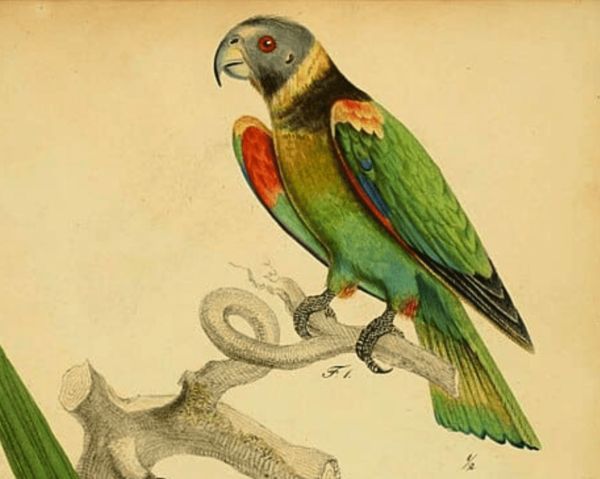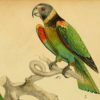
Pyrilia

vulturina
Size:
23 cm (9 in)
Weight:
120 g (4.2 oz)
Subspecies including nominate:
one
Colour Adult:
Both adults in general green; brown/yellow, bare forehead; yellow/brown lores and chin; black, bare crown to ear coverts and cheeks; occipital band reaching to throat yellow, bordered by black nuchal collar; dull olive/yellow upper breast with light black scalloping; red/orange bend of wing; red/orange lesser wing coverts; red carpal edge, axillaries and underwing coverts. Beak green/grey with yellow spot at base of upper mandible. Eye orange.
Colour Juvenile:
Brown/yellow, bare lores to area around eye, the remainder of head dull green and feathered; occipital band and nuchal collar absent; dull yellow/green upper breast; orange/yellow bend of wing and lesser wing coverts. Beak yellow in young birds.
Call:
Calls in flight are distinctive and flowing, a two-syllable series of notes.
More Information:
Content Sources:
CITES
BirdLife International
Cornell Lab of Ornithology/Birds of the World
Parrots: A Guide to Parrots of the World, Juniper and Parr, 1998
Parrots of the World, Forshaw, 2006. 2010 edition
Parrots in Aviculture, Low, 1992.
Lexicon of Parrots, Thomas Arndt.
Captive Status:
Not found in aviculture; probably never kept outside of Brazil.
Longevity:
—
Housing:
Large, sheltered aviary, indoors if in cold climate; minimum temperature 20 C (68 F).
Diet:
Tropical fruits such as guava, mango, papaya; various other fruits; seed mix such as: safflower, millets, oats, hemp and some sunflower seed; green leaves such as: Swiss chard, lettuce, sowthistle, kale, dandelion, chickweed; vegetables such as: carrot, celery, green beans and peas in the pod; minced baby food; vitamins and supplements; complete kibble if taken.
Enrichment:
—
Nest Box Size:
—
Clutch Size:
Not recorded.
Fledging Age:
—
Hatch Weight:
—
Peak Weight:
—
Weaning Weight:
—
World Population:
Unknown but described as uncommon. Decreasing.
IUCN Red List Status:
Least Concern
CITES Listing:
Appendix II
Threat Summary:
Uncommon within its relatively small range. There is no known pressure from trade. The population trend has not been investigated directly, but the species is assessed as being in decline due to the loss, fragmentation and degradation of its habitat. Over the past three generations (13.5 years), 11% of tree cover was lost within its range. Since 2016, deforestation has been accelerating at a 17% rate over three generations. The species appears to have some degree of tolerance of habitat degradation. Tentatively, declines are 10-19% over three generations.
Range:
E Amazonia in NE Brazil from E Amazonas to Para-Maranhao border.
Habitat:
Found up to 400 m (1312 ft) in lowland tropical rainforest in both varzea and terra firme forest.
Wild Diet:
Feeds on fruits, seeds and berries.
Ecology and Behaviour:
Social. Seen usually in pairs during breeding season; outside season in groups of up to 10 birds. Quiet and easily overlooked in canopy foliage.
Clutch and Egg Size:
Not recorded.
Breeding Season:
Not recorded.
Related Links:
—

